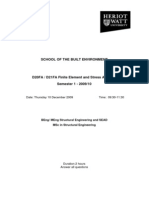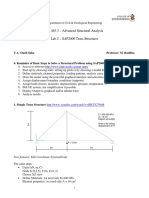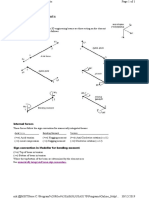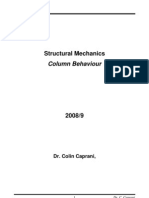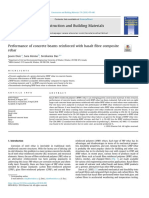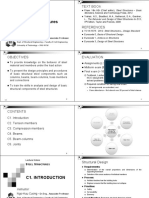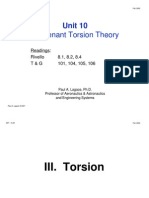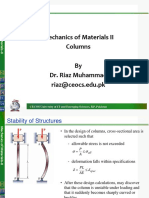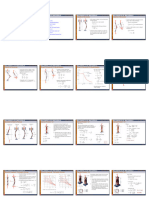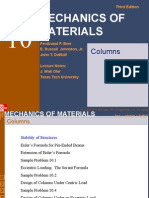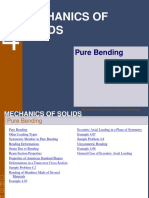CHAPTER MECHANICS OF
SOLIDS
10 Columns
GIK Institute of Engineering Sciences and Technology
MECHANICS OF SOLIDS
Columns
Stability of Structures
Euler’s Formula for Pin-Ended Beams
Extension of Euler’s Formula
Design of Columns Under Centric Load
Design of Columns Under an Eccentric Load
GIK Institute of Engineering Sciences and Technology 10 - 2
MECHANICS OF SOLIDS
Stability of Structures
• In the design of columns, cross-sectional area is
selected such that
- allowable stress is not exceeded
P
all
A
- deformation falls within specifications
PL
spec
AE
• After these design calculations, may discover
that the column is unstable under loading and
that it suddenly becomes sharply curved or
buckles.
GIK Institute of Engineering Sciences and Technology 10 - 3
MECHANICS OF SOLIDS
GIK Institute of Engineering Sciences and Technology 10 - 4
MECHANICS OF SOLIDS
GIK Institute of Engineering Sciences and Technology 10 - 5
MECHANICS OF SOLIDS
Stability of Structures
• Consider model with two rods and torsional
spring. After a small perturbation,
K 2 restoring moment
L L
P sin P destabilizing moment
2 2
• Column is stable (tends to return to aligned
orientation) if
L
P K 2
2
4K
P Pcr
L
GIK Institute of Engineering Sciences and Technology 10 - 6
MECHANICS OF SOLIDS
Stability of Structures
• Assume that a load P is applied. After a
perturbation, the system settles to a new
equilibrium configuration at a finite
deflection angle.
L
P sin K 2
2
PL P
4 K Pcr sin
• Noting that sin < , the assumed
configuration is only possible if P > Pcr.
GIK Institute of Engineering Sciences and Technology 10 - 7
MECHANICS OF SOLIDS
Euler’s Formula for Pin-Ended Beams
• Consider an axially loaded beam.
After a small perturbation, the system
reaches an equilibrium configuration
such that
d2y M P
2
y
dx EI EI
d2y P
2
y0
dx EI
• Solution with assumed configuration
can only be obtained if
2 EI
P Pcr
L2
P
cr
2 E Ar 2
2E
A 2
L A L r 2
GIK Institute of Engineering Sciences and Technology 10 - 8
MECHANICS OF SOLIDS
Euler’s Formula for Pin-Ended Beams
• The value of stress corresponding to
the critical load,
2 EI
P Pcr
L2
P P
cr cr
A A
cr
2 E Ar 2
L2 A
2E
critical stress
L r
2
L
slenderness ratio
r
• Preceding analysis is limited to
centric loadings.
GIK Institute of Engineering Sciences and Technology 10 - 9
MECHANICS OF SOLIDS
Extension of Euler’s Formula
• A column with one fixed and one free
end, will behave as the upper-half of a
pin-connected column.
• The critical loading is calculated from
Euler’s formula,
2 EI
Pcr
L2e
2E
cr
Le r 2
Le 2 L equivalent length
GIK Institute of Engineering Sciences and Technology 10 - 10
MECHANICS OF SOLIDS
Extension of Euler’s Formula
GIK Institute of Engineering Sciences and Technology 10 - 11
MECHANICS OF SOLIDS
Sample Problem 10.1
An aluminum column of length L and
rectangular cross-section has a fixed end at B
and supports a centric load at A. Two smooth
and rounded fixed plates restrain end A from
moving in one of the vertical planes of
symmetry but allow it to move in the other
plane.
a) Determine the ratio a/b of the two sides of
the cross-section corresponding to the most
efficient design against buckling.
L = 20 in. b) Design the most efficient cross-section for
the column.
E = 10.1 x 106 psi
P = 5 kips
FS = 2.5
GIK Institute of Engineering Sciences and Technology 10 - 12
MECHANICS OF SOLIDS
Sample Problem 10.1
SOLUTION:
The most efficient design occurs when the
resistance to buckling is equal in both planes of
symmetry. This occurs when the slenderness
ratios are equal.
• Buckling in xy Plane:
1 ba3 2
2 I a a
rz 12
z rz
A ab 12 12
Le, z 0.7 L
• Most efficient design:
rz a 12 Le, y
Le, z
• Buckling in xz Plane: rz ry
1 3
2 I y 12 ab b2 b 0 .7 L 2L
ry ry
A ab 12 12 a 12 b / 12
Le, y 2L a 0 .7 a
0.35
ry b / 12 b 2 b
GIK Institute of Engineering Sciences and Technology 10 - 13
MECHANICS OF SOLIDS
Sample Problem 10.1
• Design:
Le 2L 220 in 138.6
ry b 12 b 12 b
Pcr FS P 2.55 kips 12.5 kips
Pcr 12500 lbs
cr
A 0.35b b
cr
2E
2 10.1 106 psi
Le r 2
138.6 b 2
L = 20 in.
12500 lbs 2 10.1 106 psi
0.35b b 138.6 b 2
E = 10.1 x 106 psi
P = 5 kips b 1.620 in.
a 0.35b 0.567 in.
FS = 2.5
a/b = 0.35
GIK Institute of Engineering Sciences and Technology 10 - 14
MECHANICS OF SOLIDS
GIK Institute of Engineering Sciences and Technology 10 - 15
MECHANICS OF SOLIDS
GIK Institute of Engineering Sciences and Technology 10 - 16
MECHANICS OF SOLIDS
Design of Columns Under Centric Load
• Previous analyses assumed
stresses below the proportional
limit and initially straight,
homogeneous columns
• Experimental data demonstrate
- for large Le/r, cr follows
Euler’s formula and depends
upon E but not Y.
- for small Le/r, cr is
determined by the yield
strength Y and not E.
- for intermediate Le/r, cr
depends on both Y and E.
GIK Institute of Engineering Sciences and Technology 10 - 17
MECHANICS OF SOLIDS
Design of Columns Under Centric Load
• For Le/r > Cc
Structural Steel
2E cr
cr all
American Inst. of Steel Construction Le / r 2 FS
FS 1.92
• For Le/r > Cc
Le / r 2 cr
cr Y 1 2
all
2Cc FS
3
5 3 L / r 1 L / r
FS e e
3 8 Cc 8 Cc
• At Le/r = Cc
2 2 E
cr 1
2 Y
Cc2
Y
GIK Institute of Engineering Sciences and Technology 10 - 18
MECHANICS OF SOLIDS
Design of Columns Under Centric Load
• Alloy 6061-T6
Aluminum Le/r < 66:
Aluminum Association, Inc. all 20.2 0.126Le / r ksi
139 0.868Le / r MPa
Le/r > 66:
51000 ksi 351 103 MPa
all
Le / r 2
Le / r 2
• Alloy 2014-T6
Le/r < 55:
all 30.7 0.23Le / r ksi
212 1.585Le / r MPa
Le/r > 66:
54000 ksi 372 103 MPa
all
Le / r 2
Le / r 2
GIK Institute of Engineering Sciences and Technology 10 - 19
MECHANICS OF SOLIDS
Sample Problem 10.4
SOLUTION:
• With the diameter unknown, the
slenderness ration can not be evaluated.
Must make an assumption on which
slenderness ratio regime to utilize.
• Calculate required diameter for
assumed slenderness ratio regime.
• Evaluate slenderness ratio and verify
initial assumption. Repeat if necessary.
Using the aluminum alloy2014-T6,
determine the smallest diameter rod
which can be used to support the centric
load P = 60 kN if a) L = 750 mm,
b) L = 300 mm
GIK Institute of Engineering Sciences and Technology 10 - 20
MECHANICS OF SOLIDS
Sample Problem 10.4
• For L = 750 mm, assume L/r > 55
• Determine cylinder radius:
P 372 103 MPa
all
A L r 2
60 103 N 372 103 MPa
c 18.44 mm
c 2
0.750 m
2
c/2
• Check slenderness ratio assumption:
c cylinder radius
L L 750mm
r radius of gyration 81.3 55
r c / 2 18.44 mm
I c 4 4 c assumption was correct
A c 2 2
d 2c 36.9 mm
GIK Institute of Engineering Sciences and Technology 10 - 21
MECHANICS OF SOLIDS
Sample Problem 10.4
• For L = 300 mm, assume L/r < 55
• Determine cylinder radius:
P L
all 212 1.585 MPa
A r
60 103 N 0.3 m 6
212 1.585 10 Pa
c 2 c / 2
c 12.00 mm
• Check slenderness ratio assumption:
L L 300 mm
50 55
r c / 2 12.00 mm
assumption was correct
d 2c 24.0 mm
GIK Institute of Engineering Sciences and Technology 10 - 22
MECHANICS OF SOLIDS
Design of Columns Under an Eccentric Load
• An eccentric load P can be replaced by a
centric load P and a couple M = Pe.
• Normal stresses can be found from
superposing the stresses due to the centric
load and couple,
centric bending
P Mc
max
A I
• Allowable stress method:
P Mc
all
A I
• Interaction method:
P A Mc I
1
all centric all bending
GIK Institute of Engineering Sciences and Technology 10 - 23









